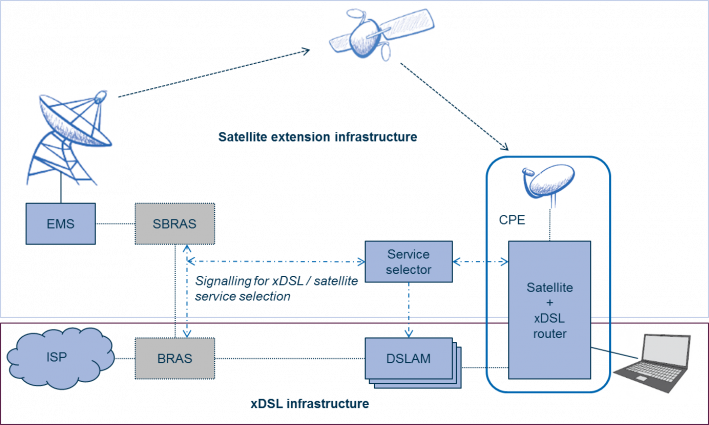-
StatusCompleted
-
Status date2016-03-17
-
Activity Code1C.014
The study objectives are to:
- Define the impacts on the current architecture of xDSL and satellite networks of such an integration,
- Define the corresponding modes of operations and specific protocols to be put in place,
- Propose a preliminary design and cost of a satellite network addressing this type of network ,including the need for signalling,
- Identify the potential impact on the value chain and in the overall telecommunications market of such an approach,
- Identify the benefits of using satellite user terminals in conjunction with xDSL user terminals (in particular on the cost for users, service delivery and installation),
- Identify the benefits of this approach with respect to terrestrial-only solutions or satellite-only solutions,
- Propose a road map for any technology development, validation, early introduction (with existing satellite networks) and full scale deployment (with dedicated satellite capacity) of such a network solution.
Key issues addressed by the study include the size of the addressable market, if and how it is possible to reallocate the downstream xDSL bandwidth that is freed up by the use of the satellite channel to improve the upstream performance of the xDSL lines involved, and how the system should be designed to enable it to be incorporated easily in existing xDSL networks and managed using existing operations support and business support systems.
The main benefits of the proposed system compared to bi-directional satellite broadband platforms are that the CPE is less expensive and easier to install (because it is receive only) and that the amount of satellite capacity required for each subscriber is reduced (because the satellite channel supplements the terrestrial channel at times when high bandwidth is required rather than replacing it entirely). This may mean that the hybrid solution is more cost-effective than alternative methods of improving the performance of slow xDSL lines, such as running fibre to the cabinet to shorten the copper loop length.

The figure shows a potential diagram for the satellite extension. The key components are:
- Service selector – communicates with other components of the complete system, to gather information on when to change the operational mode (transmission method) for a user.
- Satellite broadband remote access server (SBRAS) –separates routing paths depending on the service selection assessment (service selector), including signalling between DSLAM, teleport and end-user terminal.
- Encapsulation and modulation subsystem (EMS) – If a DVB standard is selected for the transmission of data over satellite, i.e. DVB-S2 or similar, the IP data provided by the SBRAS will need to be encapsulated and then modulated in order to be transmitted via satellite.
- Customer premises equipment (CPE): composed of an indoor unit (satellite + xDSL router) and an outdoor unit (DTH-like satellite receive antenna and universal LNB) – The satellite router is a device that receives the satellite signal and extracts the transmitted network packets. The CPE’s indoor unit will be the device that merges the traffic from the two different communication paths (xDSL and satellite), before sending it to the end user’s computer.
RF – Represented by the transmission antenna – top left in the figure-, is used as a name to gather all commonly used subsystems that are needed to send data to satellite: frequency converters, amplifiers, antenna etc.
The study was completed in 1Q 2014. The major activities were:
- Review of xDSL limitations and market (4Q 2012)
- Development of reference scenarios (1Q 2013)
- Evaluation of possible options (1Q 2013)
- Detailed design of selection option (1Q 2013-2Q 2013)
- Examination of impact on existing technologies (3Q 2013)
- Examination of impact on current value chain (3Q 2013)
Definition of roadmap and synthesis (4Q 2013-1Q 2014)
The study has been completed and all deliverables submitted.




